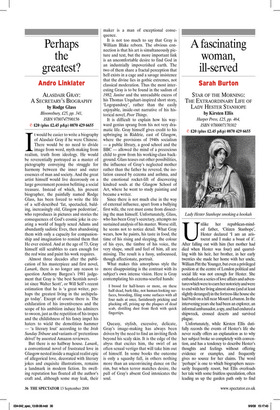Perhaps the greatest?
Andro Linklater
ALASDAIR GRAY: A SECRETARY’S BIOGRAPHY by Rodge Glass Bloomsbury, £25, pp. 341, ISBN 9780747590156 ✆ £20 (plus £2.45 p&p) 0870 429 6655 It would be easier to write a biography of Alasdair Gray if he were Chinese. There would be no need to divide image from word, myth-making from realism, truth from ideology. He would be reverentially portrayed as a master of pictography conveying the struggle for harmony between the inner and outer essences of man and society. And the great artist himself would live decorously on a large government pension befitting a social treasure. Instead of which, his present biographer, the painfully named Rodge Glass, has been forced to write the life of a self-described ‘fat, spectacled, balding, increasingly old, Glasgow pedestrian’, who reproduces in pictures and stories the consequences of God’s cosmic joke in creating a world of hugely sexed Adams and abundantly sadistic Eves, then abandoning them with only a capacity for companionship and imagination to remind them that He ever existed. And at the age of 73, Gray himself still scrabbles to earn enough for the red wine and paint his work requires.
Almost three decades after the publication of his masterpiece and first novel, Lanark, there is no longer any reason to question Anthony Burgess’s 1981 judgement that Gray is ‘the best Scottish novelist since Walter Scott’, or Will Self’s recent estimation that he is ‘a great writer, perhaps the greatest living in the archipelago today’. Except of course there is. The exhilaration of his inventiveness and the scope of his ambition induce his admirers to swoon, just as the repetition of his tropes and the childishness of his fancy impel his haters to wield the demolition hammer — ‘a literary lout’ according to the Irish Sunday Tribune and variants of ‘pretentious drivel’ by assorted Amazon reviewers.
But there is no halfway house. Lanark, a conventional novel of frustrated love in Glasgow nested inside a magical realist epic of allegorical love, decorated with literary jokes and exquisite illustrations, remains a landmark in modern fiction. Its swelling reputation has floated all the author’s craft and, although some may leak, their maker is a man of exceptional consequence.
It is not too much to say that Gray is William Blake reborn. The obvious connection is that his art is simultaneously picture and text, but the more important link is an uncomfortable desire to find God in an industrially impoverished earth. The two of them share a fractal perception that hell exists in a cage and a savage insistence that the divine lies in gothic extremes, not classical moderation. Thus the most interesting Gray is to be found in the sadism of 1982, Janine and the unreadable excess of his Thomas Urquhart-inspired short story, ‘Logopandocy’, rather than the easily enjoyable, inside-out narrative of his historical novel, Poor Things.
It is difficult to explain how his wayward genius sprang from his not very dramatic life. Gray himself gives credit to his upbringing in Riddrie, east of Glasgow, where the provisions of 1940s socialism — a public library, a good school and the BBC — allowed the mind of a precocious child to grow from his working-class background. Glass teases out other possibilities, the influence of Gray’s neglected mother rather than the father he revered, the isolation caused by eczema and asthma, and the emotional rocket-lift of discovering kindred souls at the Glasgow School of Art, where he went to study painting and became a writer.
Since there is not much else in the way of external influence, apart from a bullying first wife, the rest must come from dissecting the man himself. Unfortunately, Glass, who has been Gray’s secretary, attempts no sustained analysis of his master. Worse still, he seems not to notice detail. What Gray wears, how he paints, his taste in food, the time of his rising and sleeping, the colour of his eyes, the timbre of his voice, the very shape, smell and feel of him, all are missing. The result is a fussy, unfocussed, though affectionate, portrait.
What makes this amorphous style the more disappointing is the contrast with its subject’s own intense vision. Here is Gray contemplating his eczema-scurfed hands:
I brood for half-hours or more, on these half-dead, bark-like, not human-looking surfaces, brooding, filing some surfaces with all four nails at once, fastidiously pricking and plucking off, prising up the plaques of dead scab, distilling dust from flesh with quick fingertips.
Queasy, stylish, excessive, delicate, Gray’s image-making has always been driven by the need to find an inviting flesh beyond his scaly skin. It is the edge of the abyss that excites him, the swirl of an often sexual vertigo that will take him out of himself. In some books the outcome is only a squashy fall, in others nothing more than an unconvincing dance on the rim, but when terror matches desire, the pull of Gray’s absent God intoxicates the soul.










































































 Previous page
Previous page